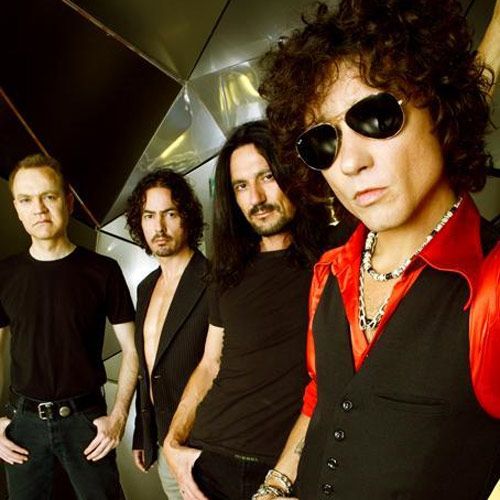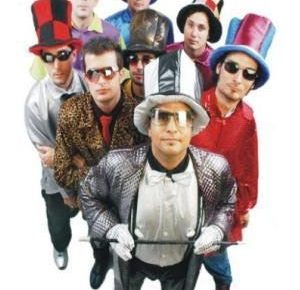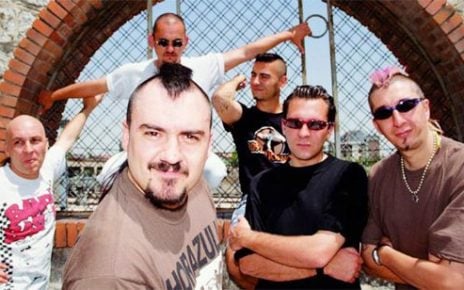Héroes del Silencio (sometimes referred to as just Héroes) was a Spanish rock band from Zaragoza (Aragón, Spain) formed by Juan Valdivia.
In the 1990s they experienced success around Spain and the Americas, and various European countries including Germany, Belgium, Switzerland, France, Serbia and Portugal becoming a successful Spanish group and a fact in the history of the Rock en Español scene.
After ten years and numerous albums, the band broke up in 1997. When the main singer Enrique Bunbury went solo, other members of the band also found a different musical path in life. In 2007, as part of a 20-year anniversary celebration and 10 years after their break-up, they organized a 10-concert world tour.
Héroes del Silencio started in 1984 as a band named Zumo de Vidrio and consisting of Juan Valdivia, his brother Pedro Valdivia and their cousin Javier Guajardo Valdivia. Some time later Enrique Bunbury joined the line-up. Bunbury was originally a bass player but after Juan Valdivia heard him singing a David Bowie song and told him that he had a great voice, Bunbury became the vocalist.
The band changed their name to Héroes del Silencio in 1986. At first they played in public places and made demos but their break came when they participated in a music contest in Salamanca and won second place – an EMI producer, Gustavo Montesano, saw the band in the contest and some time later, at a concert in Sala En Bruto, he signed the band.
Their first album, “Héroe de Leyenda”, was released in in 1987 and sold 30,000 copies. The following year, the album “El Mar No Cesa” was released, featuring the songs “Mar Adentro”, “Agosto” and “El Estanque”, and sold 100,000 copies. The supporting tour followed in 1989, documented on the limited edition live album “En Directo”.
In 1990 they released “Senderos de Traición”, their best-selling album with 2 million copies, including 400,000 copies in the first two weeks in Spain alone. The following year they started the tour “Senda 91” and released another live album, “Senda ’91”.
1992 saw the most important CD in their career, “El Espíritu del Vino”. They sold 600,000 copies of this album which was played throughout America. They followed this with a tour for “El Espíritu del Vino”. In 1993, Alan Bogulavsky joined the band.
Due to tensions within the band, they took a hiatus and went to Benasque to take a vacation and heal the rifts within the group. After this break they gained a new producer, Bob Ezrin (Lou Reed, Pink Floyd, Peter Gabriel, Alice Cooper, Kiss, etc.) and in 1995 released “Avalancha”, widely considered their best album. “Avalancha” was more hard rock than previous albums, with songs like “Avalancha”, “Deshacer el Mundo” and “Iberia Sumergida”. The album was followed by the Avalancha tour in 1995 and 1996, which produced the live album “Parasiempre”.
The band split in 1996 though this did not prevent the release of the “Rarezas” album in 1998.
20 years after their first album, and 11 years after they split up, the band announced a ten-day reunion tour that would take them to Guatemala City, Buenos Aires, Monterrey, Ciudad de México, Los Ángeles, Sevilla, Zaragoza and Valencia. For this tour guitarist Gonzalo Valdivia (Juan Valdivia’s brother) replaced former band member Alan Boguslavsky. More than 10,000 people attended each concert, some of the concerts saw as many as 90,000 fans (Sevilla). The tour was followed by another live album, “Tour 2007”.
After the tour Singer-songwriter Enrique Bunbury announced his new album, focusing in his solo career.
The outline of Heroes style can be defined in well-crafted lyrics, complex arpeggios and a strong rhythmic base. The metamorphosis undergone by the band throughout its history has it been since they can be pigeonholed in a genre of music .
While his first album was considered pop-rock group’s musical evolution was to hard rhythms, and some specialized media have labeled as rock, and even hard rock, depending on the album. People have also used uncommon terms to describe his style as “rock epic” and “messianic rock.”
His first work, The sea does not cease was the most pop of the group, influenced by the production of Gustavo Montesano and trends of the time . A very acoustic sound, batteries sequenced and little prominence of the guitar playing gave the album a very pop tone.
The change of production in 1991 brought greater emphasis to the guitars and rhythm rocker, the singer also used a tone worst of vocalization. The powerful voice of Bunbury, sometimes defined as a baritone, became one of the hallmarks of the band.
Also worth mentioning the lyrics to Enrique Bunbury, one of the personal characteristics of the band, scheduled by critics as cryptic and “expressive darkness.” In general, compositions are ambiguous, hermetic and symbolic, very different interpretations given to.
These features reached their highest state in the spirit of wine (Bunbury said years later that those letters arrived at bringing disparate vivid dreams under the influence of drugs), defined by some media as “tyrannical poetry” , to become more explicit in Avalanche.
The subjects mentioned by Hero in his songs are diverse, but had special marine reminiscences on his first album, in which up to four issues relate to the sea, in addition to appearing on the cover an image of the group on some rocks by the sea.
Throughout the 1990s came in many ways an insistent comparison between Heroes del Silencio and The Mission, a British gothic rock band formed in 1986. In this regard, Bunbury said: “I do not see the group is the Spanish Mission. I do not think we look like nothing. But when anyone can buy an album and recommend it, it does by comparing it’s not derogatory, but to give a rough idea. ” The press also often attributed influences of Led Zeppelin, Guns N ‘Roses and The Doors. In this regard, Henry went on to say: “When I compare think Jim Morrison with my likeness goes beyond cutting hair.”
Heroes del Silencio have always been surrounded by a very careful and particular symbology, designed from the first album by the Firm Pedro Delgado, Madrid, who had worked for several Spanish artists. Already in his first album, The sea stops, designed to cover the shield with two dragons together forming an “H” was very well received and, slightly modified, was the emblem of the group for the next disc.
With the spirit of wine, plus a musical turn, was seen also a turning point in his image and the disk. The study design adapted the ideas of the group to the album booklet. It created a monogram for each topic, linked to it but ignoring its meaning, and a representative symbol of each group member (even though they had already been used in Path 91).
The main novelty was the representative image of the band, consisting of an “H” and “S” superimposed its logo would become final. In Avalanche used this same symbol retouched, and further work was used as a generic picture of Heroes del Silencio.





